The rifle we are looking at is an early Mondragon bolt-action design, model of 1894. Prior to designing his self-loading 1908 rifle (which is notable as the first self-loader adopted by a national military), Manuel Mondragon created this bolt action design. He was working in Switzerland at the time, and the guns were actually built by SIG. Thanks to reader Bruce, we have photographs of the very first one of these rifles produced (it is engraved “1” in several places, and devoid of other markings).

This rifle has several very interesting features, and shows us some of the ideas being contemplated at that time. It is a straight-pull bolt action design, but the utility of rapid repeating fire was in its nascent stages. Instead of adding the extra complexity for a self-loading design, Mondragon put three selector settings on the 1894 rifle. Two are the typical “safe” and “fire”, and the third is for rapid fire. In this setting, the firing pin is released to fire a cartridge automatically when the bolt is fully closed. So the shooter needs only run the bolt back and forth to quickly empty the magazine, much like holding down the trigger on a Winchester 1897 shotgun and having it fire as you pump the action.
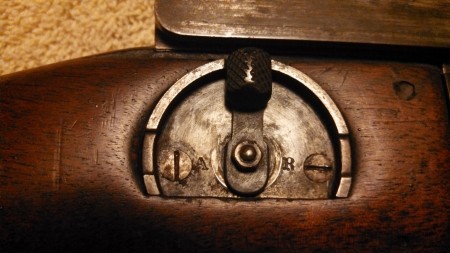
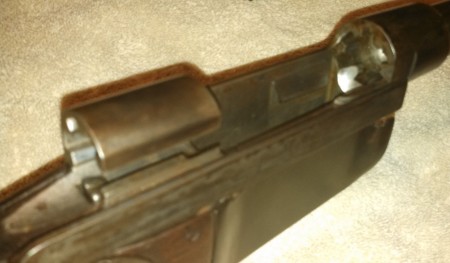
This early Mondragon rifle was made in two calibers. One was a fairly typical 6.5mm round, and the other was an unusual 5.2 x 68mm cartridge developed by Colonel Rubin (of Schmidt-Rubin rifle fame). It was an attempt to get a high velocity smallbore projectile with the less than fully developed smokeless powder that was then available. The cartridge used an internal piston, so that the case volume increased (and thus the pressure was moderated) as the bullet initially left the case. The rifle was have photos of here is in this 5.2mm caliber, which was ultimately dropped. Better powder made its special featured unnecessary, and it also occasionally had problems with the piston breaking up and lodging in the bore.


The 1894 Mondragon fed these cartridges from a 6-round en bloc clip much like that of the US M1 Garand (the 6.5mm version of the Mondragon held 8 rounds in the clips). A loaded clip would be loaded into the top of the action with the bolt open, and a catch in the back of the magazine well would hold it in place. A small lever in front of the trigger guard allowed a partially loaded clip to be removed. The magazine floorplate had a pair of flat springs fitted to it, which pushed upwards on a follower plate to feed the cartridges up to the bolt. The rear end of the follower had a swallowtail cut so that it would fit inside the walls of the en bloc clip.
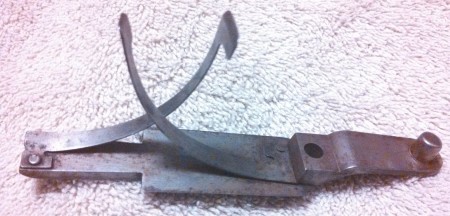
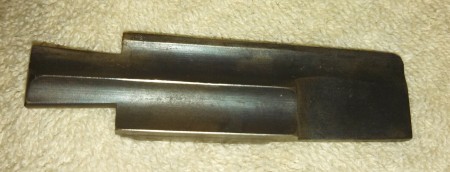
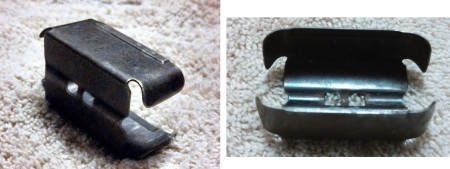
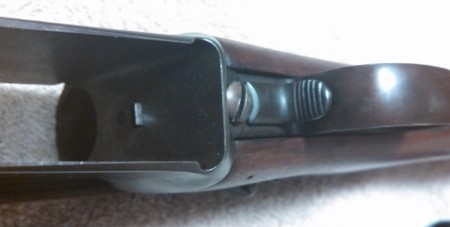
The rifle used a very modern-looking bolt with two sets of six small locking lugs arranged radially, very reminiscent of a Johnson or AR bolt. One set up lugs locked into the front of the receiver, and the second set was located at the rear of the bolt, behind the magazine. Inside the bolt was a simple firing pin/striker with a captive spring and a foot to catch on the trigger mechanism.
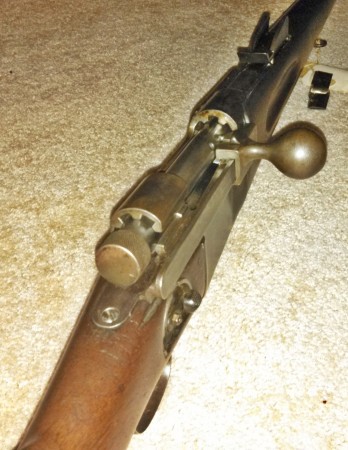

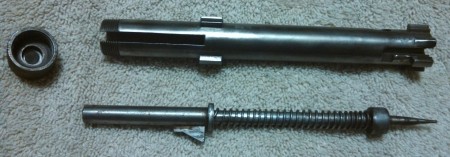
A cam track in the side of the bolt (no visible in any of our photos, unfortunately) was engaged by a lug on the bolt handle, forcing the bolt to rotate and lock and the end of its forward travel. In addition to the cam and groove, the bolt handle rode on a rail on the right side of the receiver.
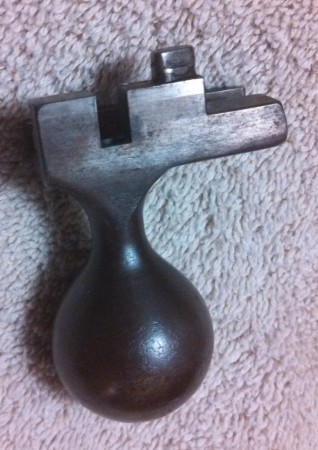
The idea of allowing the rifle to fire upon bolt locking without use of the trigger may have seemed to have potential back when this rifle was being made, but it creates a huge safety hazard. One would have to be extremely aware of the selector position if planning to carry the rifle with a round chambered. The model 1894 never saw significant production, possibly for this very reason. However, Mondragon continued his work in arms development, and later created the Model 1908 self-loader. Interestingly, the 1908 still showed evidence of concern with bolt action and rapid fire use, as it incorporated a catch allowing the shooter to deactivate the gas system and operate the rifle as a straight-pull bolt action.
Additional photos:

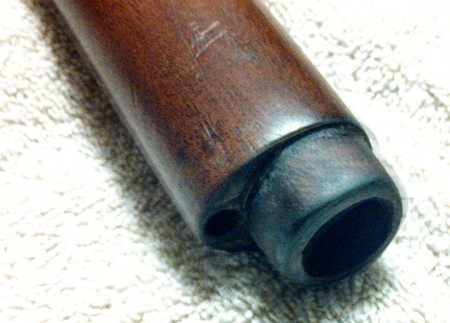
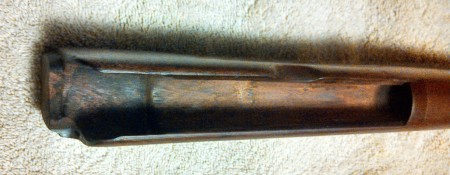
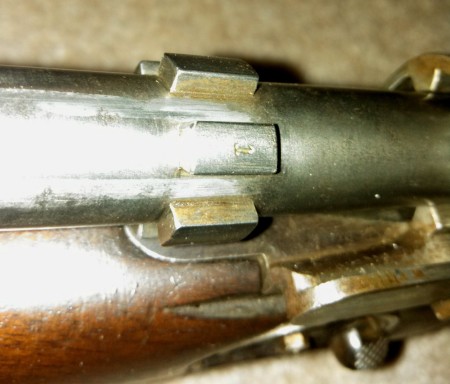
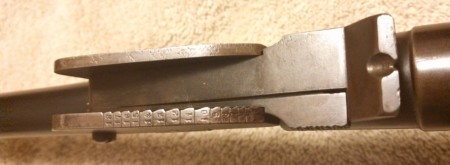
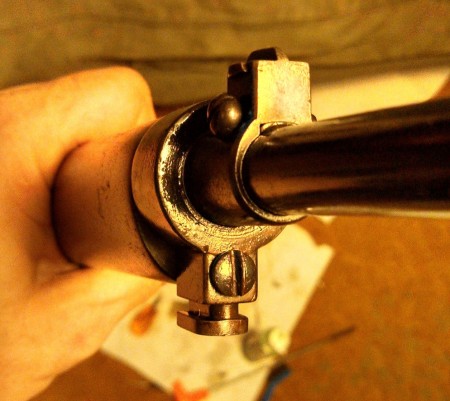
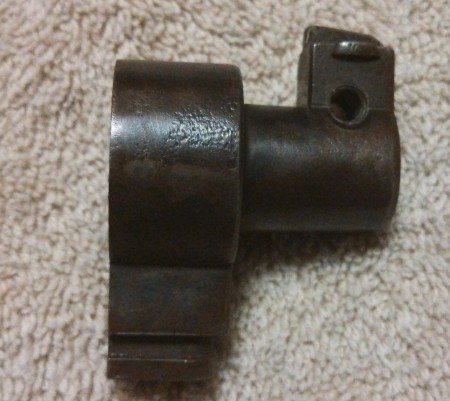


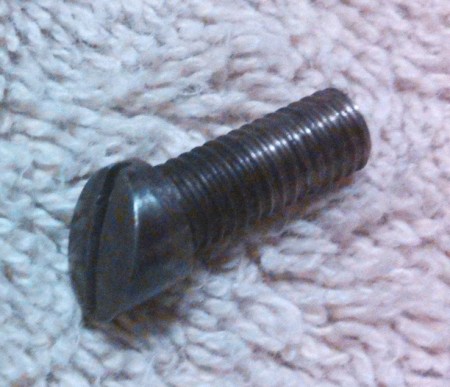


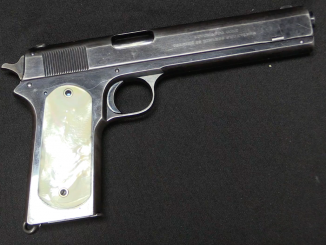

From the pics initially, it looks like the French stole the design for the MAS Bolt action!?!?
Everything has been done before, and will be done again. I wonder if Melvin Johnson had ever seen one of these to design his “Johnson Locking Lugs”? I guess you just can’t get around that nasty bit of Physics???
Hmmm, I don’t think so… As Ian wrote, the Mondragon Model 1894 uses a straight-pull bolt action design and as such is quite different (and unusual!). What looks indeed similar to the MAS 36 and the earlier Lebel rifles is the solid machined encasing beneath the action that houses the magazine.
One thought I’d have is complexity of locking. To have both sets equally engaged and loaded must have put high demand on accuracy of parts. In any case, the inventor was a genius in his own right.
The question is, were both sets to engage by design? The Mauser 98 system has an additional rear locking lug, but it’s not supposed to be engaged during normal operations and only act as a safety feature in case you shear the front lugs.
Pickiing up on Capital Ordnance’s about the Johnson Locking Lugs….is there any evidence regarding where John Garand came up with the 8 round enbloc? That Mondragon developed something similar here seems too much a coincidence. Did Mondragon’s autoloader have a similar concept? As with many things in life I’m sure it was true for firearms designers – “plagarism is the finest form of flattery” – improve on a good idea.
En bloc clips weren’t unique to Mondragon – they had been used in several of the really early German selfloading pistols in the 1880s and 1890s, as well as in several bolt action rifles around this time. The double stack element to them may have been introduced by Mondragon, though…
i’m pretty sure i have read somewhere (sorry no source) that the original garand had a ten round enblock clip, but was in a experimental caliber. When they converted it to the larger 30.06 it could only fit 8 rounds.
Yes, in .276 Pedersen the M1 held 10 rounds.
Some of the pieces bear a striking resemblence to the Model 1893 Mannlicher which SIG was making for Swiss cavalry troops. Given that the Swiss were never very happy with the Model 1893 due to its (lack of) performance, it appears that SIG may have been facilitating Mondragon’s developments to get a superior rifle design for cavalry service.
Jonh D.: Yes, that makes sense (the stock and the front band, not to mention the sights, all scream “Model 1893”). Ian has some interesting Swiss books – already reviewed here – on local small arms development, and he might be able to search there for additional info, although I do think those books are limited to automatic weapons.
What an effort and energy to search and write such amazing informative posts
in a very short time intervals. Thanks for all.
You never see these rifles or the cartridges.I am curious as to the performance of those cartridges. Thanks for the very interesting presentation.
There was a good article on Mondragon and his creations in one of the Guns & Ammo annuals.
The career of Manuel Mondragon and his many firearms innovations reminds one yet again of the tendency of too many in the Western world to consistently under-estimate the design ( and, more recently, manufacturing ) capabilities of many Latin American nations. So many rock-solid, well-made and functionally outstanding models of firearms have originated in countries auch as Mexico, Brazil, Chile and Argentina, but they have not gotten as much acknowledgement concerning their qualities as they deserve, at least up until recently.
On that note, is anyone on this site familiar with the Brazilian Uirapuru 7.62mm GPMG designed by Olympio Vieira De Mello and manufactured by Mekanika Industria e Comercio Ltd.? From what I have read about it, it is supposed to be a pretty good weapon that fulfills its intended design functions admirably, even though it is not an aesthetically-pleasing gun, and is a little on the heavy side ( 28 lbs with bipod ). The Brazilian Army has seen fit to replace its FN MAG58’s with the Uirapuru, so that would appear to say much for the latter.
Earl, thanks for mentioning the Uirapuru GPMG. Olympio Vieira de Mello was a truly gifted designer, and while the weapon was indeed very good, it was never adopted by the Brazilian military.I should note that Mr. Vieira de Mello created the company Mekanika Indústria e Comércio Ltd. with the aim of producing his own Uru SMG (which was the object of an excellent article on FW by the renowed Brazilian gun writer Ronaldo Olive). Eventually, the production suffered several delays but that is another story, as the saying goes. Nevertheless, the Uru was adopted by Brazilian police and military forces.
As for the Uirapuru (a small singing bird from the Amazon) 7.62mm GPMG, its development actually started at the IME (Instituto Militar de Engenharia) around 1968, by a team led by Nelmo Suzano. At first, the experimental weapon received a funny name, “Maria Bonita” (the girlfriend of a famous bandit that roamed the Brazilian Northwest in the 1920s), and only later got its avian designation, more or less officially. The “Maria Bonita” project was interrupted at the IME in 1972, only to be resumed by the end of the decade by the already mentioned Mekanika Indústria e Comércio Ltd., at the hands of a team that included Nelmo Suzano but also Olympio Vieira de Mello. The prototype was ready in 1979. Besides from a few test specimens, the production never took place. The information available is scanty to say the least. I am aware of an article by Rolando Olive, published in the June ’80 issue of the magazine “Brasil Defesa”: “Uirapuru: uma nova metralhadora brasileira” (“Uirapuru: a new Brazilian machine gun”).
Ruy, good to hear from you — It looks as if my source concerning the intended general adoption of the Uirapuru as the Brazilian Army’s next-generation GPMG was incorrect, after all, and I myself stand humbly corrected.
I wonder if the publicity about the Uirapuru replacing the MAG was a preliminary announcement made just a little too soon based on an anticipated outcome (that turned out very differently in the end due to other decision-making factors on the part of the authorities)? Certainly, it has been quoted by more than one firearms source as fact, so perhaps the timing also played a part in this process.
Thanks so much for the additional insightful information about IME, the “Maria Bonita” project, etc. ; I learned something new, and sharing knowledge as well as learning from one another is what this site is all about!
You are welcome, Earl. Unfortunately, the notion that the Uirapuru GPMG had been adopted by the Brazilian army spread long ago (in the Eighties, I suppose – I remember reading about it in some generic write-up on modern machine guns around 1990) and was kept alive in many English language sources till now, more than 30 years after the prototypes were tested! No matter what might have happened, the fact remains that the gun was very well received back then (and that includes the local specialised press). It may help explain why, all of a sudden, people started to propagate the notion that it was either on the verge of being adopted or even already adopted, so your are probably right… Sadly for the designers and perhaps for the Brazilian armed forces too, it didn’t happen. This is true of many other interesting developments from that ‘Golden Era’ of the Brazilian defence industry (roughly early to late-Eighties) ranging from promising tracked APCs right to state-of-the-art MBTs.
As a digression, I should have mentioned that the real Maria Bonita was the girlfriend of Virgulino Ferreira da Silva, aka Lampião, perhaps the most famous cangaço band leader from the 1920s and 1930s. Lampião and his group met their end at the ends of a police unit armed with Hotchkiss LMGs, possibly of the Portative model sold to Brazil (like this one – http://www.youtube.com/watch?v=kCsBbu7nzqI) or perhaps the magazine-fed M 1922, which is even more likely given the date of the gunfight (July 1938).
Earl, I found the source where I read about a possible adoption of the Uirapuru by the Brazilian Army – it is general survey on machine guns, written by Terry Gander (The Machine Gun: a modern survey,London, PSL, 1993). Well, twenty years, this is what had to say about it, after a laconic feature on the gun (pp. 149-151):
“Apparently the Uirapuru operates well and is now in service with the Brazilian Army, where it is used both as a light and medium machine gun. Co-axial and pintle versions are understood to be in production for armoured vehicles, and a solenoid-operated version is available for use on aircraft and helicopters”.
Oh well…
Earl, I found the source where I read about a possible adoption of the Uirapuru by the Brazilian Army – it is a generic overview on machine guns written by Terry Gander (The Machine Gun: a modern survey, London, PSL, 1993). Well, twenty years ago this is what he had to say about it, after a laconic feature on the gun (pp. 149-151):
“Apparently the Uirapuru operates well and is now in service with the Brazilian Army, where it is used both as a light and medium machine gun. Co-axial and pintle versions are understood to be in production for armoured vehicles, and a solenoid-operated version is available for use on aircraft and helicopters”.
Oh well…
Ruy, thank you once again for the additional, and highly enlightening, information. It definitely helps to clear things up quite a bit! You are also right about the Brazilian armoured fighting vehicle designs and their unfulfilled potential. I remember constantly reading about them in highly-respected defence publications such as “International Defence Review” and “NATO’s Fifteen Nations”.
And again you are welcome, Earl! As for the Brazilian vehicles, you can find a write-ups (in Portuguese though) on the light EE-T4 “Ogum” APC (Ogum is the blacksmith orixá, one of the many deities – orixás – that belong to the afro-brazilian pantheon from Bahia):
http://www.forte.jor.br/blindados/2-ee-t4-ogum/
http://www.ecsbdefesa.com.br/fts/Ogum.pdf
Fortunately, two of the four prototypes originally built by Engesa are kept in running condition (one was restored to a very high standard two years ago, if my memory serves me well).
I just noticed a silly mistake I made above; where I wrote “Lampião and his group met their end at the ends…”, I should have written “Lampião and his group met their end at the hands…”. Sorry!
That 5.2 x 68mm Rubin round is really interesting , as it also appears to attempt ( coincidentally, or otherwise ) to incorporate the ballistic advantages of a sub-calibre bullet in a full-sized cartridge a la APDS, minus the sabot of course, and with the addition of the “piston”. And it was conceived long before the APDS concept, or even Edgar Brandt’s 105mm / 75mm saboted long-range artillery round, was ever dreamed up.